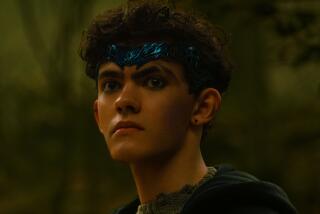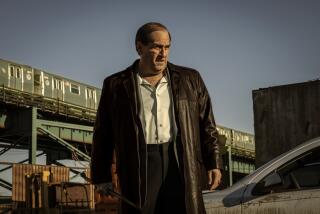‘Loki,’ Marvel’s latest TV show, is a twisted time adventure. Here’s the backstory
This story contains spoilers for the series premiere of “Loki” on Disney+.
The first episode of “Loki” is here and it is burdened with glorious purpose: to kick off a time adventure starring a beloved character who can appeal to the broadest range of viewers.
The third Disney+ original series from Marvel Studios, out now, “Loki” follows the titular God of Mischief after the events that took place during “The Avengers” (2012) as depicted in “Avengers: Endgame” (2019). If that sounds a little complicated, this guide is for you.
As Marvel Cinematic Universe faithful will recall, saving the day in “Endgame” involved the heroes going on a time heist to borrow Infinity Stones from various points in the past to use in the film’s present. One of these attempts, which took the Avengers of the “Endgame” era to the “Avengers” time period, was unsuccessful and resulted in the Loki of “The Avengers” stealing one of the powerful stones and making his escape.
This Loki that escaped is the protagonist in the Disney+ show. Because he was plucked from the timeline, he is not the same Loki audiences saw in films the followed “The Avengers,” such as “Thor: The Dark World” (2013) and “Thor: Ragnarok” (2017).
“The most important thing from a character standpoint was bringing this version of Loki up to speed on just what was the character growth that he was supposed to have in another version of his life, had he not been pulled in by the [Time Variance Authority],” “Loki” head writer Michael Waldron told The Times. “We felt that was really important because the audience had experienced that character growth with Loki and I didn’t want to somehow invalidate that with this story.”
Director Kate Herron said that the team, including Loki actor Tom Hiddleston, brainstormed to figure out which moments from his past would really capture the character’s arc from the movies.
“I think something we all came to together was, obviously, Frigga, because she’s his heart,” she said. “I really wanted to show that he would want to reach out and touch his mum and stop [her death] from happening. And then he finds out he’s, unfortunately, the one responsible.”
Waldron also explained that for the premiere episode, it was important for the show to “establish the rules of time travel in a way that hopefully makes sense and can withstand a week’s worth of scrutiny between each episode. And deliver those rules in an entertaining fashion that doesn’t put the audience to sleep.”
“The time travel that was created and discussed in ‘Endgame,’ that was our jumping-off point,” said Waldron. “So everything we did had to line up logically with that and we just wanted to expand on it.”
This included introducing new Marvel entities like the Time Variance Authority, which has its roots in Marvel’s comics. Here’s the backstory behind the new characters and organizations introduced in the first episode of “Loki.”
“Falcon and the Winter Soldier” head writer Malcolm Spellman and director Kari Skogland on Sam Wilson, Bucky Barnes and how Marvel Studios set up its new TV show.
Who are the Time Keepers?
As explained by Miss Minutes in a video Loki was forced to watch before facing trial for committing a time crime, the Time Keepers came into existence after “a vast multiversal war” involving various timelines almost wiped out reality. These all-powerful beings reorganized the multiverse into one sacred timeline. They now protect the proper flow of time for everyone and everything.
In the comics, the Time Keepers wield almost limitless powers over time manipulation and are guardians over the stream of time. They’re not infallible and are also willing to do whatever it takes to preserve their existence, which has pitted them against various teams such as the Avengers.
What is the Time Variance Authority?
As explained in “Loki,” the Time Variance Authority is an organization created by the Time Keepers to uphold the sanctity of the timeline and all reality. Its job is to make sure that the one true “sacred timeline” remains intact by nipping any possible branches that sprout from establishing alternate timelines and creating alternate universes. The TVA itself exists outside of the flow of time.
The TVA made its first comic book appearance in “Thor” in the 1980s. Similar to its onscreen incarnation, the TVA in comics monitors the multiverse and erases any timelines that are perceived to be too dangerous. The bureaucratic agency also steps in to stop those who try to meddle with the past or future, though that doesn’t mean it always prevents everyone from time travel or altering reality.
In the comics, the final chairman of the Time Variance Authority created the Time Keepers.
Why does “Nexus event” sound familiar?
When someone does something that veers them off the proper timeline established by the Time Keepers, it is called a Nexus event. The individuals that step off their paths are called variants.
But this is not the first mention of “Nexus” in the MCU: “Nexus” is the name of one of the products highlighted in a fake commercial that was shown during “WandaVision.”
In comics, the Nexus of All Realities is a mystical gateway that links every dimension. Additionally, the comic book Scarlet Witch is one of the rare individuals known as a Nexus being. A Nexus being is someone “who belongs equally to all possible timelines — all realities and divergencies,” at least according to Agatha Harkness in a 1990 issue of “West Coast Avengers.”
In Marvel’s “WandaVision,” nothing is as it seems. So we prepared an episode-by-episode guide to the Disney+ series for you to keep handy as you watch.
Is Agent Mobius, played in the series by Owen Wilson, from Marvel comics too?
Yes, there is indeed a Mobius M. Mobius who appears in the comics and works at the TVA. He first appeared in an issue of “Fantastic Four” in the ‘90s as a lower-management type (though he was later promoted).
How about Judge Renslayer?
Ravonna Renslayer, played in “Loki” by Gugu Mbatha-Raw, is also a character from Marvel comics, one who’s used a few aliases since her first appearance in a 1965 issue of “Avengers.”
In the comics, Ravonna is a princess from the 41st century of an alternate timeline whose storyline has involved the complicated time-traveling villain Kang the Conqueror, who is expected to appear in “Ant-Man and the Wasp: Quantumania.”
More to Read
The complete guide to home viewing
Get Screen Gab for everything about the TV shows and streaming movies everyone’s talking about.
You may occasionally receive promotional content from the Los Angeles Times.







